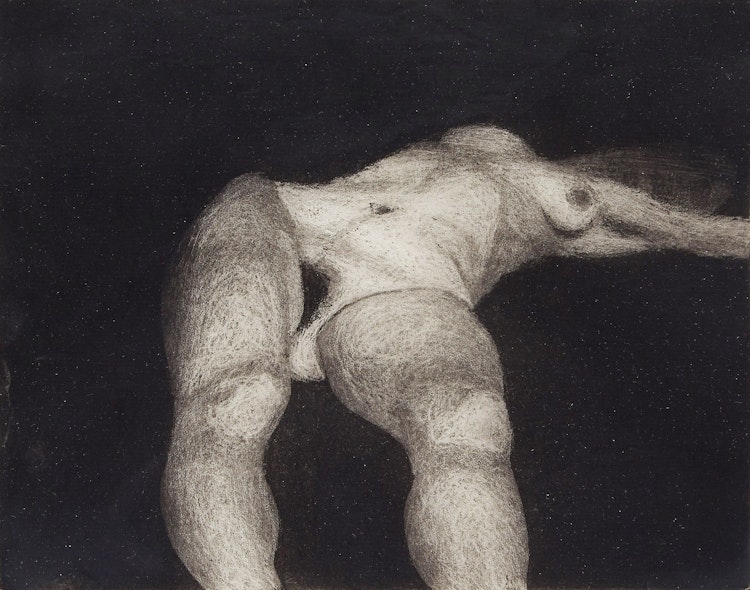Repose by Hugh Mackenzie

Hugh Mackenzie
Repose
aquatint on zinc
signed and numbered 3/15 in the lower margin
7 x 8.75 ins ( 17.8 x 22.2 cms ) ( subject )
Auction Estimate: $150.00 - $250.00
Price Realized $118.00
Sale date: December 12th 2019
Share this item with your friends
Hugh Mackenzie
(1928)
Born in Toronto, Ontario, the son of Mr. & Mrs. Hugh A. MacKenzie, he studied at the Ontario College of Art, Toronto, where he received first class honours. He travelled in Europe and worked in Paris (1952). He took further study at Mount Allison University under Alex Colville (1952-54), where he received his B.F.A. MacKenzie began to attract attention in group shows as early as 1953. One of his oil paintings, “Freight Yards”, was reproduced in the Windsor Daily Star during the exhibition “Young Contemporaries” at the Willistead Art Gallery. For about four years, he worked as a commercial artist in Toronto (1954-59).
In 1960, during a three-man show at the London Public Art Museum, his work was praised by Lenore Crawford as follows, “It was three years ago last October that Mr. MacKenzie…held his first exhibit here. At that time, he was working in various media and was in an experimental stage of technical development, In the intervening period, he has decided on his medium – at least for the present – and all his paintings are in casein. A draftsman, the meticulous minute-stroked technique he uses fascinates him, instead of making him impatient and he find plenty of scope for expression in the medium which has clarity as its prime quality. This is the story told by a collection of his work done during 1958 and 1959…. Technically, the paintings engender respect because, although the painting is fine-stroked, there is a feeling of sweep to it and no hint of fussiness. People are him for him vehicles of expression; they exist as personalities, but they also project thoughts and feelings which come from the artist concerning human relationship to natural elements, to other human beings and to what one calls ‘the world’. There is probing depth, particularly in the more recent works, which commands attention and inspires thought. There are no more surface studies of people.”
In 1961, MacKenzie was elected to the Ontario Society of Artists and received the J.W.L Forster Award for the best subject painting at the O.S.A. Annual Exhibition. In the years that followed he moved steadily into prominence. In the show “Magic Realism in Canadian Painting” at the London Art Gallery organized by Paddy Gunn O’Brien in 1966, his self-portrait which won the J.W.L. Forster Award was described by Lenore Crawford as “the ultimate” and that the work stood head and shoulders above any other painting in the show. His other works in the exhibit also showed that he had achieved the combination of seriousness and appealing warmth. It was not surprising therefore that when the field of portrait artists had been considered for the commission to paint retiring Prime Minister Pearson’s official House of Commons portrait, that MacKenzie was chosen.
After three weeks of careful thought to the matter, he accepted and was formally commissioned by the Secretary of State’s office. He managed to get three sessions with the Prime Minister during which time he photographed him, did tempera sketches of his hands, mouth and nose, and then returned to his studio to begin the final portrait. It took two months, working seven hours a day, to complete the work. As it turned out, the portrait not only pleased the Pearsons but also the majority of other viewers.
His 1969 solo show at the Jerrold Morris Gallery, Toronto, was noted by Ross Mendes as follows, “His paintings, generally modest in size, are executed in egg-tempera on Masonite, emphasizing his preference for drawing over colour. Although in MacKenzie’s works there is no sense of ease of drawing, there is no sense of striving either. Somewhere between them both, there is a zone of deliberate achievement. His precise touch with fine brushes enables him to describe subtle variations in a surface without over-emphasis using the tonal hatchings of brush marks ‘that cross and cross and cross’ his forms. He has a preference for dusty colours: brick, flesh tones, ochres, rusts. The egg-tempera medium compliments this with its characteristic chalky quality. MacKenzie’s tightly controlled colour is an antidote to the uncontrolled technicolour of most movies or the shiny colours of slick magazines. If you have ever taken a colour transparency you have probably noticed that the front porch, or whatever it may be, appears freshly painted even when you know it’s not. The distortion in film and in reproduction tends to sweeten everything.” This showing included ten tempera paintings on panel, nine drawings in charcoal, pencil, wash and pencil, pen, and one small sketch in tempera. He taught life-drawing at the Beal Technical School, London, Ont., before moving to Toronto, where he began to paint full time. He was represented in many important public and private collections.
Source: "A Dictionary of Canadian Artists, Volume 4: Little - Myles", compiled by Colin S. MacDonald, Canadian Paperbacks Publishing Ltd, Ottawa, 1978

